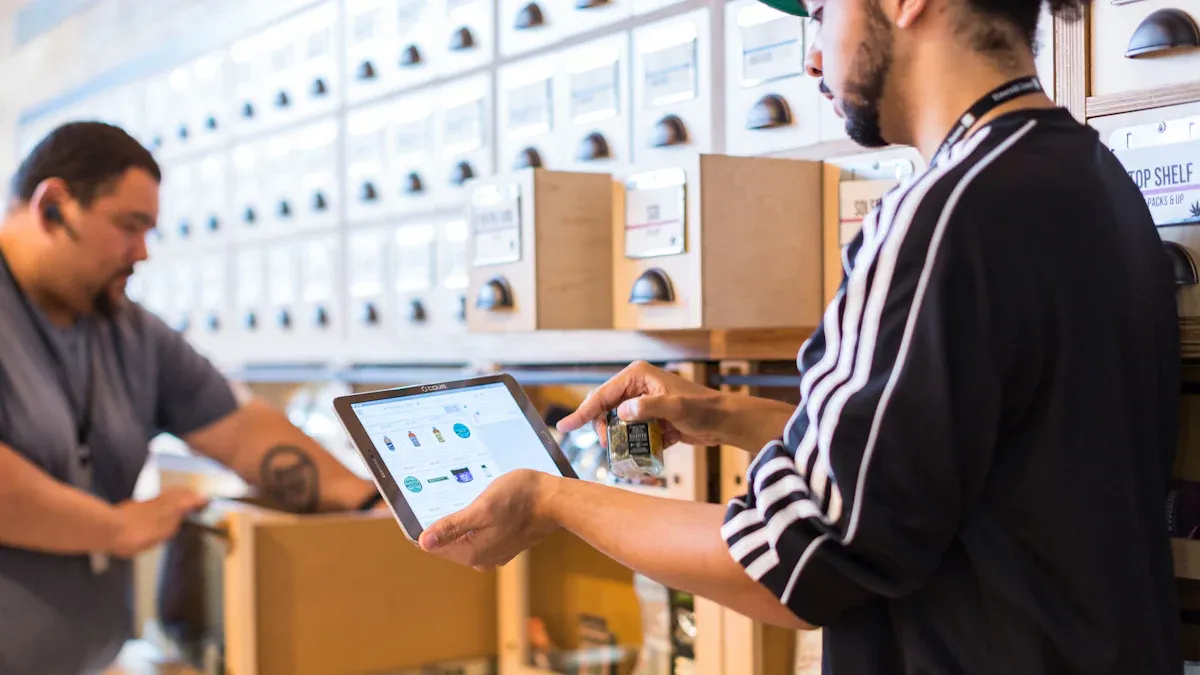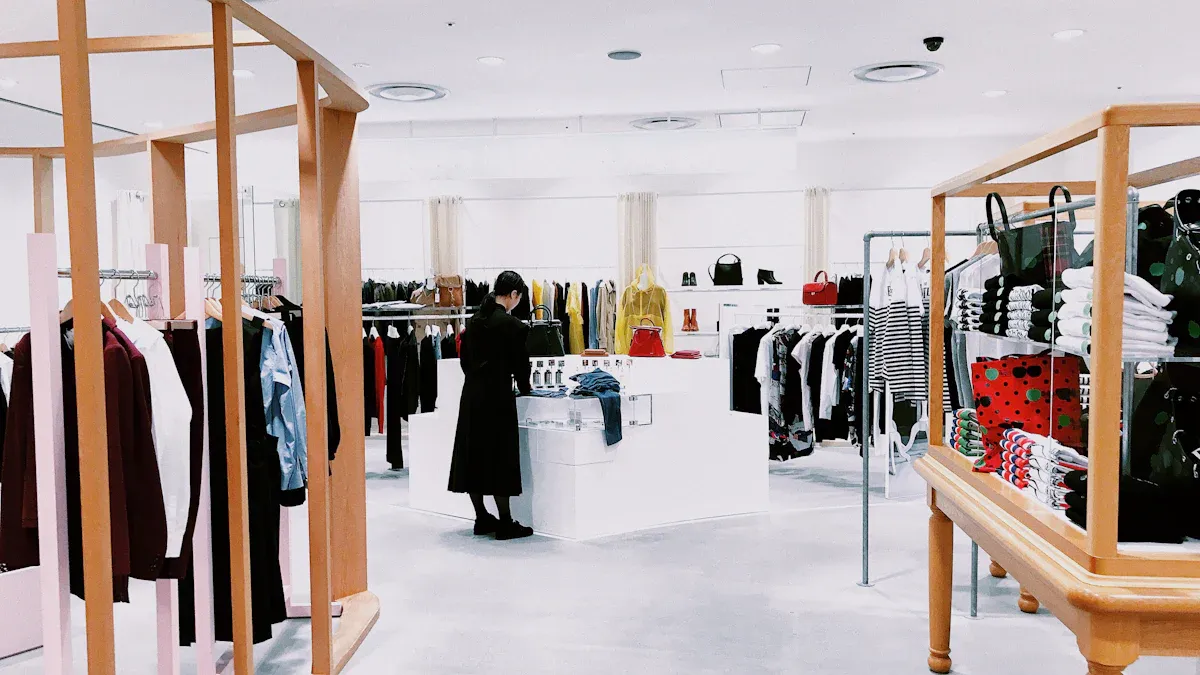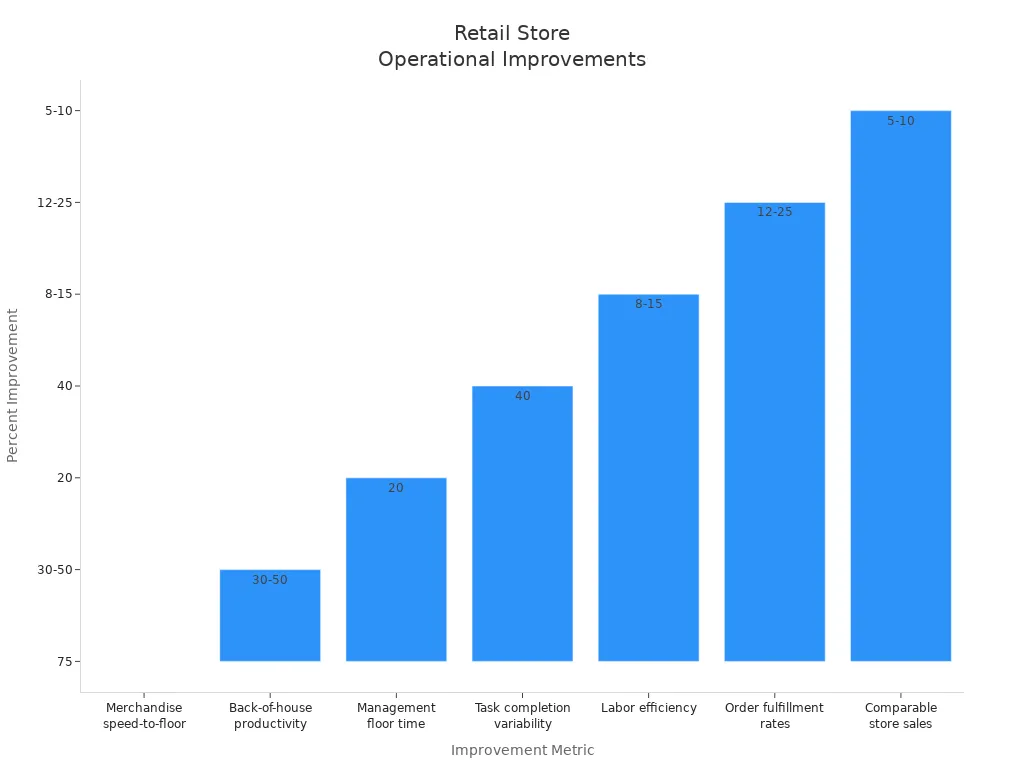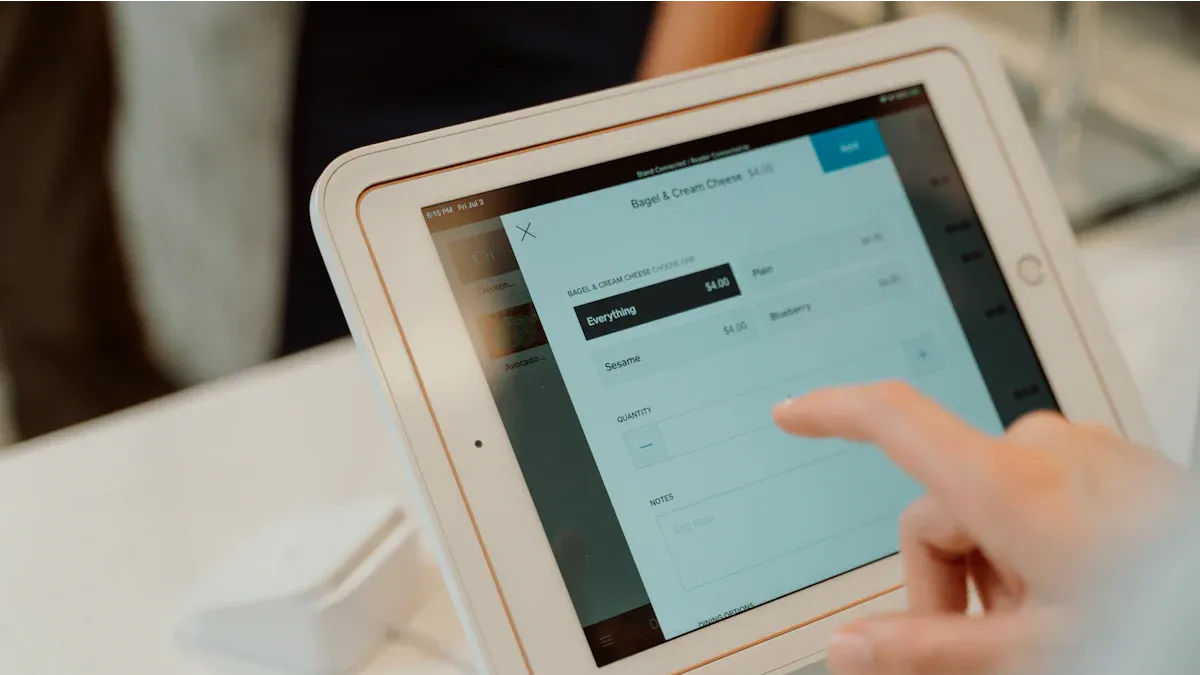Retail Store Ops

Retail Store Ops covers all the daily tasks, systems, and processes you need to run a store, whether online or in person. Imagine walking into a store where shelves stay stocked, staff greet you with a smile, and checkout runs smoothly. You notice how much easier shopping feels. The way you manage inventory, staff, and customer service shapes this experience.
Operational Focus | Impact on Customer Satisfaction |
|---|---|
Boosts brand perception and satisfaction | |
Accurate inventory and smooth processes | Increases loyalty and sales |
Consistency across shopping channels | Enhances loyalty and satisfaction |
Standardized processes and staff training | Raises satisfaction scores |
Understanding these pieces helps you spot what works and what needs fixing.
Key Takeaways
Effective Retail Store Ops improve customer satisfaction. Keep shelves stocked and staff trained to create a pleasant shopping experience.
Use technology like POS systems and inventory software. These tools help manage sales, track stock, and streamline operations.
Focus on staff training and scheduling. Well-trained employees provide better service and help reduce turnover rates.
Implement omnichannel strategies. Allow customers to shop online and in-store for a seamless experience that boosts loyalty.
Regularly analyze data to spot trends. Use insights to make informed decisions and improve store performance.
Retail Store Ops Overview

Definition
You manage Retail Store Ops by organizing all the systems and processes that keep your store running smoothly. This includes both online and physical stores. You set up the store layout to guide customers and make products easy to find. You track inventory so shelves stay stocked and customers get what they want. You train staff to help shoppers and answer questions. You handle cash and payments to make checkout fast and secure. You use technology to connect your store with online channels, making shopping easier for everyone.
Tip: When you plan Retail Store Ops, you improve customer satisfaction and boost sales. Integrated systems let you fulfill online orders from your physical store, which increases efficiency and helps you pool inventory.
You see the difference when you use a mix of digital and physical channels. Omnichannel operations let you serve customers wherever they shop. You need efficient planning to manage these channels and keep everything working together.
Daily Activities
You handle many daily activities in Retail Store Ops. These tasks keep your store organized and ready for customers. Here are the main categories:
Retail Management: You oversee administration, customer service, and store design.
Cash Handling: You follow cash register procedures, order cash and coin, and make cash drops.
Security: You protect merchandise and secure the building.
You also use several systems and processes every day:
Store Layout and Design: You arrange products to guide customer flow and increase visibility.
Inventory Management: You track stock levels and avoid running out of popular items.
Sales and Customer Service: You train staff to help customers and solve problems.
Staff Management: You schedule shifts and motivate your team.
Cash and Financial Handling: You process payments and follow financial rules.
Daily tasks look different in online and physical stores:
Customer Service: In physical stores, you greet shoppers and answer questions face-to-face. Online stores use AI and chatbots to help customers any time.
Inventory Management: Physical stores rotate stock and manage perishable goods. Online stores keep inventory in one place, which makes order fulfillment easier.
Shopping Experience: Physical stores give instant access to products and social interaction. Online stores require shipping and may have limited stock.
Operational Challenges: Physical stores manage stock across many locations. Online stores centralize inventory, which streamlines operations.
Experience: Physical stores let customers touch and see products. Online stores do not offer this immediacy.
Logistics: Online stores store products in one location. Physical stores must manage inventory in several places.
Note: When you combine digital and physical operations, you create a better shopping experience. You use your store to fulfill online orders and improve service levels.
Key Components
Inventory
You manage inventory to keep products available and avoid stockouts. You can use several techniques to improve inventory control. Order larger quantities of popular items so customers always find what they want. Use demand planning with data from all sales channels to predict needs. Real-time stock tracking helps you spot shortages quickly. Automated tracking systems can reduce stockouts by 30-50%, which means fewer lost sales.
Technique | Description |
|---|---|
Order larger quantities | Prevents stockouts by keeping popular items in stock. |
Improve demand planning | Uses sales data for accurate predictions. |
Real-time stock tracking | Identifies shortages across all channels. |
Automated tracking | Cuts stockouts by up to 50%, boosting sales. |
Real-time tracking also improves profitability. You get accurate inventory data, which helps you fulfill orders faster and avoid mistakes. You can lower carrying costs and improve cash flow. When you track inventory well, you create a reliable shopping experience.
Staff
You need the right staffing model to keep your store running smoothly. Coverage ratio measures how well you match staff levels to customer traffic. Schedule stability means most shifts stay the same after posting, which helps employees plan. Shift preference fulfillment shows how often you meet staff requests. Giving advanced notice for schedules builds trust. Automated scheduling can save up to 75% of your time.
Tip: Low turnover rates help you keep experienced staff. High turnover leads to more training, higher costs, and lower morale. Stable teams deliver better service and improve your brand reputation.
Customer Service
You create a positive experience by focusing on customer service. Friendly staff, flexible schedules, and a supportive environment help employees feel valued. When employees feel committed, they serve customers better. You can measure customer service with metrics like Customer Satisfaction (CSAT), Net Promoter Score (NPS), and Customer Effort Score (CES). High scores mean customers return and recommend your store.
Customer Service Metric | Impact on Store Performance |
|---|---|
CSAT | Repeat visits, higher value |
NPS | Loyalty, more referrals |
CES | Retention, satisfaction |
Financials
You track financial metrics to measure success. Gross Margin Return on Investment (GMROI) shows how well inventory generates profit. Sales per employee measures productivity. Inventory turnover tells you how often you sell and replace stock. You also watch operating expenses, quick ratio, and cash conversion cycle to keep your store healthy.
Operating Expense (OPEX): Daily costs like rent and payroll.
Quick Ratio: Ability to pay bills without selling inventory.
Inventory Turnover: How often you sell and restock items.
Customer Retention Rate: Percentage of customers who return.
Technology
You use technology to make Retail Store Ops more efficient. AI and machine learning help you forecast demand. Augmented reality engages customers. Omnichannel strategies, like buy online and pick up in store, meet customer needs. Secure payment systems and IoT tools, such as smart shelves, improve accuracy. Real-time analytics optimize stock levels and reduce losses. Self-checkout kiosks and mobile payments speed up checkout, making shopping easier.
Note: Investing in technology boosts customer experience and operational efficiency. Many retailers now focus on data, analytics, and AI to stay competitive.
Importance
Profitability
You can boost your store’s profits by focusing on efficient operations. When you optimize Retail Store Ops, you create a positive shopping experience and maximize sales. This approach leads to higher profits and better customer satisfaction. Efficient operations help you control costs and improve your bottom line.
Cost of Goods Sold (COGS): Lower COGS by negotiating better prices and managing inventory well.
Operational Expenses: Keep expenses like rent and salaries in check by optimizing staffing and negotiating leases.
Sales Volume: Increase sales to spread fixed costs and get better deals from suppliers.
Optimizing your store’s daily processes is crucial for success in today’s competitive retail world. You need to keep your operations running smoothly to maintain a healthy profit margin.
Customer Experience
You shape the customer experience every day. Personalization makes shopping more enjoyable. Use data and AI to recommend products and offer special promotions. This approach brings customers back and increases satisfaction.
Personalization helps you connect with shoppers.
Omnichannel experiences let customers shop online or in-store without problems.
Good operations make shopping easy, even during busy times or crises.
Strategy | Impact on Customer Experience |
|---|---|
Interactive Displays | Engage shoppers and encourage return visits. |
Loyalty Programs | Build loyalty and turn buyers into regular customers. |
Store Cleanliness | Create a positive first impression and build trust. |
Omnichannel Integration | Make shopping seamless across all channels. |
Customer Feedback | Help you improve by listening to shoppers’ needs. |
Growth
You set the stage for growth by improving your store operations. Proactive pricing strategies help you stay competitive. Watch market trends and adjust prices to attract more customers. Quick responses to complaints and community involvement also drive growth.
Join community activities to build goodwill.
Use loyalty programs and delivery services to reach more people.
Aspect | Importance |
|---|---|
Supply Chain Scalability | |
Staffing Plans | Train new employees to keep service levels high. |
Technology Infrastructure | Make sure your systems can handle more stores. |
Standard Procedures | Use clear processes to repeat your success in new locations. |
Modular Construction | Open new stores faster and keep quality high. |
Optimization Strategies
You can make your store run better by using smart strategies. These methods help you save time, cut costs, and improve customer service. Let’s look at four ways to optimize your Retail Store Ops.
Automation
Automation helps you finish tasks faster and with fewer mistakes. You can use special tools to manage audits, track attendance, and handle schedules. These tools also help you keep your store safe and organized.
Taqtics lets you track audits and attendance across all your stores.
SafetyCulture uses AI templates to manage resources and keep things running smoothly.
Simplifield gives you clear workflows and lets you customize tasks for your team.
WorkForce Suite helps you plan staff schedules and match them to busy times.
ZetesAthena supports many store locations with strong infrastructure.
Bindy creates forms for audits and boosts productivity.
Q-nomy manages queues and appointments so customers wait less.
Natural Insight helps you make smart decisions about your workforce.
Xenia uses data to plan store functions.
Verint automates customer interactions for better service.
Tip: Automation can lower front-line labor costs by 20%. You also see a 15-20% jump in labor productivity. Automated systems predict busy hours, so you avoid overstaffing and save money.
Automation in retail makes your store more efficient. You spend less on labor and get more work done. These changes help you build a stronger business.
Data Analytics
Data analytics lets you see what is happening in your store. You can track sales, customer visits, and inventory levels. This information helps you make better decisions and spot problems early.
Platform | Key Features |
|---|---|
Live data analysis, operational data store, data warehouse, advanced analytics, real-time insights. | |
Adobe Analytics | Cross-channel attribution, real-time data analysis, advanced segmentation, AI-powered insights. |
Retail Next | In-store traffic analytics, sales attribution, heatmaps, real-time performance monitoring. |
Power BI | Customizable dashboards, data integration, predictive analytics, sales and revenue tracking. |
Oracle Data Platform gives you live data to help you run your store better.
Adobe Analytics shows you how customers behave across different channels.
Retail Next uses sensors to track how people move in your store.
Power BI helps you see and understand data from many sources.
Note: When you use data analytics, you find out what works and what needs fixing. You can adjust your plans quickly and keep your store running smoothly.
Omnichannel
Omnichannel means you connect your store with online shopping, social media, and other channels. Customers can shop in person, online, or through apps. You give them a smooth experience no matter where they buy.
Stores that use three or more channels see a 494% higher order rate than those using just one channel.
You reach more customers and keep them coming back.
You can offer services like buy online, pick up in store, or easy returns.
Tip: Omnichannel strategies boost sales and customer engagement. You make shopping easier and more fun for everyone.
Training
Training helps your team learn new skills and work better together. You can use short lessons, hands-on practice, and easy access to learning materials. Well-trained employees serve customers better and make fewer mistakes.
Category | Improvement Metrics |
|---|---|
Operational Transformation | 75% improvement in merchandise speed-to-floor |
30-50% back-of-house productivity gains | |
20% increase in management floor time during peak periods | |
40% reduction in task completion variability | |
Financial Impact | 8-15% improvement in store-level labor efficiency |
12-25% increase in omnichannel order fulfillment rates | |
5-10% improvement in comparable store sales through better execution | |
Strategic Outcomes | Enhanced brand consistency across all locations |
Improved associate retention and engagement | |
Increased customer satisfaction and loyalty scores | |
Stronger competitive positioning in omnichannel retail |

Develop training programs for managers and staff using clear procedures.
Employees who get good training feel motivated and deliver better service.
You see higher productivity and more satisfied customers.
Start with short lessons to teach basic ideas.
Use hands-on practice to build real skills.
Give access to learning materials after training for review.
Note: Training programs lead to faster merchandise placement, higher productivity, and better customer service. You also see stronger brand consistency and more loyal customers.
You can use these strategies to make your Retail Store Ops stronger. Automation, data analytics, omnichannel integration, and training all help you build a store that runs smoothly and keeps customers happy.
Challenges & Solutions
Inventory Issues
You face many inventory challenges in retail. Inaccurate records can cause lost sales and upset customers. Sometimes, your system shows products in stock, but shelves stay empty. Fresh products bring extra problems like spoilage or mistakes in weighing. You can see the main issues and solutions in the table below:
Inventory Issue | Description | Resolution Method |
|---|---|---|
Inaccurate Inventory Records | Up to 60% of retailers’ inventory records are inaccurate, leading to lost sales and customer frustration. | Advanced inventory management systems using AI and better counting methods. |
Phantom Inventory | System shows stock, but shelf is empty. | Anomaly detection and regular cycle counts to find and fix errors. |
Challenges with Fresh Products | Spoilage and mis-weighing affect inventory levels. | Improved inventory systems that adjust for unique product factors and correct errors. |
Tip: Use real-time tracking and AI tools to keep your inventory accurate. This helps you avoid empty shelves and unhappy shoppers.
Staffing
Staffing brings its own set of challenges. High employee turnover makes it hard to keep experienced workers. Many retail stores see turnover rates as high as 60% for frontline staff and 63% for managers. Seasonal peaks, like the holiday season, force you to hire quickly. In 2024, retailers added over half a million jobs just for the holidays. Outdated recruitment technology slows down hiring and raises costs.
Challenge | Evidence |
|---|---|
High Employee Turnover | Average annual turnover for frontline retail workers is 60% and 63% for managers. |
Seasonality and High Volume | Retailers added 561,800 jobs during the 2024 holiday season, highlighting recruitment spikes. |
Inadequate Recruitment Tech | Reliance on point solutions leads to inefficient processes and increased costs. |
You can solve these problems by using better scheduling tools, offering training, and investing in modern recruitment platforms. These steps help you keep good employees and fill roles faster.
Tech Adoption
You need to keep up with new technology, but this can feel overwhelming. Some staff may resist change or struggle to learn new systems. You can make tech adoption easier by choosing user-friendly tools and providing hands-on training. Start with small changes and show your team how technology makes their jobs easier. Celebrate quick wins to build confidence.
Note: When you support your team during tech upgrades, you see faster adoption and better results.
Customer Demands
Customers expect fast service, accurate orders, and a smooth shopping experience. They want to shop online, in-store, or both. You must adapt quickly to new trends and feedback. Listen to your customers, use their feedback to improve, and stay flexible. When you meet customer demands, you build loyalty and grow your business.
Tools & Tech

POS Systems
You need a reliable POS system to run your store smoothly. POS stands for Point of Sale. It helps you process sales, track inventory, and manage customer data. You can choose from several types:
Desktop Terminal POS Systems work well for stores with many products. They are easy to use and handle large inventories.
Mobile POS Systems are portable and cost less. You can use them in small shops or pop-up stores.
Multichannel POS Solutions connect your sales from online and physical stores. You see real-time inventory and avoid stockouts.
Cloud-Based POS Systems let you access data from anywhere. You get flexibility and remote management.
Modern POS systems offer many features:
Mobile payments like Apple Pay and Google Pay make checkout fast.
EMV chip card support keeps transactions secure.
Integration with payment gateways such as Square or PayPal helps you accept more payment types.
Real-time inventory tracking updates stock levels automatically.
Barcode scanning speeds up checkout and reduces mistakes.
Low-stock alerts tell you when to reorder.
Customer profiles store shopper information for personalized service.
Loyalty programs track rewards and encourage repeat visits.
Sales reports show trends and help you plan better.
Tip: A strong POS system helps you serve customers quickly and keeps your store organized.
Inventory Software
Inventory software helps you track products and sales. You see what is in stock and what needs restocking. You can print custom barcodes for each item. This makes product management easier. The software also monitors employee performance and sales. You spot trends and adjust your orders. You avoid running out of popular items and reduce waste.
Feature | Benefit |
|---|---|
Prevents stockouts | |
Barcode printing | Speeds up product handling |
Employee tracking | Improves team performance |
Workforce Tools
You use workforce tools to manage your team. These platforms help you schedule shifts, track attendance, and measure productivity. Automated scheduling matches staff to busy hours. You give employees access to their schedules and tasks. This builds trust and keeps your team motivated. Workforce tools also help you train staff and monitor progress.
Automated scheduling saves time.
Attendance tracking reduces errors.
Task management boosts productivity.
Analytics
Analytics tools give you insights into your store’s performance. You track sales, customer visits, and inventory levels. Dashboards show you what works and what needs improvement. You use these insights to make better decisions. Analytics help you spot trends, plan promotions, and adjust staffing. You keep your store running efficiently and improve customer satisfaction.
Note: Digital solutions let your team access data and insights quickly. This helps you solve problems and grow your business.
You can improve Retail Store Ops by focusing on automation, data analytics, and training. Review your processes often and look for new ways to solve problems. Use technology to make tasks easier and help your team work better. Try new ideas and learn from your results. Are you ready to take your store operations to the next level?
FAQ
What is the most important part of retail store operations?
You need to focus on inventory management. Accurate inventory helps you avoid empty shelves and lost sales. Good inventory control keeps your store running smoothly and improves customer satisfaction.
How can you improve staff performance in your store?
You should provide regular training and clear instructions. Use scheduling tools to match staff to busy times. Recognize good work to keep your team motivated.
Tip: Happy employees serve customers better and help your store succeed.
Which technology helps you manage your store better?
You can use POS systems, inventory software, and workforce management tools. These solutions track sales, monitor stock, and organize staff schedules.
Tool | Benefit |
|---|---|
POS System | Faster checkout |
Inventory Software | Accurate stock levels |
Workforce Tools | Better scheduling |
How do you handle customer complaints quickly?
You should listen carefully and respond with a solution. Offer refunds or exchanges if needed. Use customer feedback to improve your store.
Listen to the customer
Solve the problem fast
Learn from feedback
See Also
Starting an AI-Driven Corner Store on a Budget
Understanding the Growth of AI-Enhanced Corner Shops
Discovering Sensi Retail: A Cannabis Dispensary Focused on Equity
Fundamentals of Corner Stores and Their Importance
Transforming Online Store Management with AI E-Commerce Solutions
